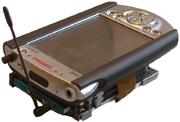|
|
|
|
Mobile devices
|
-
Since mobile devices are integral components of smart environments, the identification and tracking of those devices are prerequisites for providing context-based services. For the detection of mobile device with WLAN connectivity there is no need to employ additional sensing hardware, as a unique identification of the devices is possible by using their MAC address. If additional location information is required, commercially available programs like e.g. Ekahau are delivering adequate location information on basis of signal strength measurements.
|
- „Passive“ Mobile Devices
In our scenarios we use two types of mobile device. The first group of devices gets the information about the current location from a smart environment. Since all the computations are done by systems within the environment we refer to these devices as “passive”. The following image shows the schematic layout of the installation with 3 access points using the Ekahau Positioning Engine.
|
|

|
- Figure 1: Identification and tracking of “passive” mobile device with the Ekahau Positioning Engine and three access points
|
- „Active“ Mobile Devices
In contrast to “passive” mobile devices we call devices “active” if they are equipped with autonomous sensing hardware and thus work independent from static positioning systems. Although these devices do not depend on a environmental sensing infrastructure, the identification of ambient objects and persons does not work without RF tags. Therefore we use active RFID tags with 32 kByte of memory for object information (e.g., IP address, room number). This, for example, enables mobile devices to detect nearby network printers or large public displays.
|